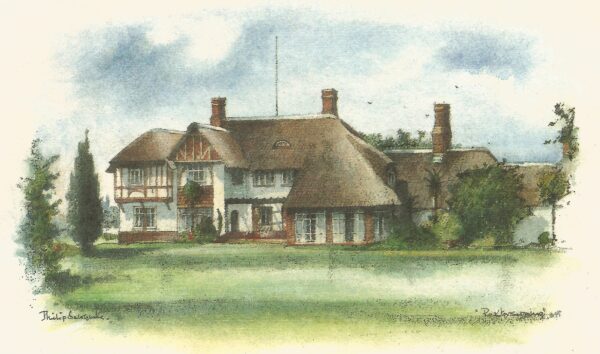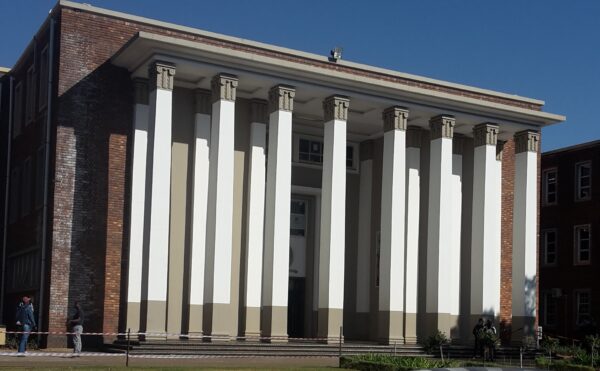From a prominent citizen who died in a plane crash in Greece to the first principal of Potchefstroom Gimnasium, Potchefstroom street names starting with a “C” tells the story of the many-faceted history of our city.
Street name and building remembers businessman
Calderbank Avenue (Dam area) was named after Mr Hugh William Hersey Calderbank, a prominent Potchefstroom businessman. This street, which stretches north from Tom Street (Steve Biko) to the Dam, was formerly known as Lakeside Road.
Calderbank had the thatched roof mansion in Calderbank Avenue built in 1942. It was bought by the Potchefstroom University in 1964, albeit not from Calderbank himself. When he and his first wife divorced in 1956, she received the property as part of the divorce settlement.
Hughie Calderbank – as he was known – played an important role in the development of the town. He sold the most expensive property in town in 1948 when the shoe firm, Cuthberts, bought the old Regent’s Café on the north-western corner of Kerk and Lombard Streets (Walter Sisulu and James Moroka) for £48 000. The Regent’s Café stood on the property once owned by OWA Forssman.
He owned Calderbank’s Garage, founded by his father, which was at 156 Church Street. The building which housed the garage still stands. The front pillars are hollow metal cylinders, to house the petrol pumps. Metal doors in the pillars, to access the pumps, are still there. The name “Calderbank’s Buildings” is still visible and on the gable the date “1930” takes pride of place.
Later the Calderbank’s Garage was situated where the parking lot of Fiti Exhaust is today in James Moroka Street (Lombard). They sold General Motors products from there.
He also built the original building of the OK Bazaars on the south-western corner of Church and Lombard Street. He was a councillor for many years and mayor in 1940/41, 1946/47.
He was a member of the city council from 1935 to 1949 and again from 1956 to 1962. He sold the garage in 1960 and he and his second wife, Pat, retired in Durban. Afterwards he flew to Potchefstroom every month for city council meetings. He died in a plane crash in Greece in October 1972, but his wife survived the crash.
According to the Potchefstroom Herald of 24 October 1972, reporting on the accident, the Calderbanks travelled on a scheduled flight from Corfu to Athens. The airplane went down into the sea about 300 m offshore, about 15 km from the Athens airport, where it was to land.

Mr Hugh Calderbank Photo: Potchefstroom Museum

Phillip Bawcombe painted the Calderbank mansion in 1988 as part of a series to celebrate the 150th anniversary of Potchefstroom. The house, generally known as the Rector’s Residence, was built by Calderbank, hence the street being named after him.

Calderbank’s garage was built in 1930 by the father of Hugh Calderbank, after which Calderbank Street was named. The petrol pumps were installed in the hollow metal pillars. The first offices of the Potchefstroom Herald, were on the premises before they moved to the neighbouring property to the south in 1927. The Herald building was then demolished to build the Calderbank building.
Coetzee Street (Bult)
According to Senex* the street was named after Mr At Coetsee, the first principal of Potchefstroom Gimnasium. Although the name is spelled with a “z”, Mr At (JJA) Coetsee’s surname was spelled with a “s”. Mr. Coetsee became the principal of the Preparatory School, which was a part of the Theological School, in 1908. The Preparatory School was founded in 1907. It became a government school in 1915 with the name Potchefstroom Gimnasium and he became the first principal of the Gimnasium. He retired in 1938. According to Potchefstroom Gimnasium 1907-1982, apart from his duties as headmaster, he also taught 28 periods per week. He was personally responsible for the classes in religion and also Afrikaans and Dutch. A former pupil remembered that he kept the reigns of the school firmly in his hand. “He was never stiff and formal, but had an easy manner in communicating with his pupils.”

Coetzee Street was named after Mr JJA (At) Coetsee, first principal of Gimnasium, although the town council inadvertently spelled the street name with a “z” instead of an “s”. Photo: Potchefstroom Gimnasium

The Preparatory School of the Theological School of the Reformed Church was housed in this building, which was erected in 1907 and today forms part of the Theological School Complex in Molen Street. It stands on the south-eastern corner of Molen and Esselen Streets. From this Preparatory School the Potchefstroom Gimnasium was founded in 1915. Photo: NWU Museum and Archives
Clark Street (Central) was named after CF Clark, who lived in Kerk Street, but had a large property which extended towards River Street on which he ran a dairy. The property was situated just south of the Queens Hotel (now Impala). The homestead of the farm stood on the site today occupied by shops next to the Land Bank. A “modern” house there was built at 19 Goetz Street, which was then part of the Clark property, in 1950 after Mr Clark retired and his daughter still lived there in 1975.
College Street (Bult) was so named because the street bordered on the terrain of the then Normal College, later known as the Potchefstroom College of Education and is a later extension of Dwars Street. College Street is now completely engulfed by the campus of the North-West University. It is the street that exits the roundabout at the Malherbe Street entrance to the campus to run south and ends beyond De Wilgers against Albert Luthuli Street.
The Normal College was founded in 1919 to fill a need for more teachers after the flu epidemic. A Normal College was opened in Potchefstroom with twenty-four students in a galvanised iron building on the grounds of the Potchefstroom High School for Boys. Some of the men were housed in buildings at Witrand and the female students in rented houses. From the beginning students of the Normal College were allowed to study at the Potchefstroom University College, enabling them to obtain a degree.
In 1920 the college was transferred in total to the cantonments at Witrand. The cantonments were galvanised iron structures imported from India after the Anglo-Boer War to house British forces in the country. A large British garrison was established at Potchefstroom, hence the availability of the buildings.
In 1923 the College, complete with all the galvanised iron buildings, was transferred to the area bordered by President and Meyer Streets and the railway line. The first permanent structure was the Van Heerden Hostel, fronting on Hoffman Street and currently known as Caput. At the time the name of the College was changed to the Potchefstroom College of Education (PCE).
The PCE flourished during the late 1970s and large plans for expansions were made. By 1992 the buildings of the PCE were transferred to the PU and in 2000 the PCE was incorporated into the university.

The Main Building of the Potchefstroom College of Education, after which College Avenue was named, was officially opened on 13 September 1940.
*The principle sources of these articles are a series of 13 columns written by “Senex” for the Potchefstroom Herald published from 17 December 1974 to 24 June 1975. Senex was the pseudonym of Mr Jurgens Smith, a long-time history teacher at the Potchefstroom High School for Boys.


